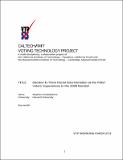Is There Racial Discrimination at the Polls? Voters' Experience in the 2008 Election
Author(s)
Ansolabehere, Stephen
DownloadWP_73_docx.pdf (99.03Kb)
Metadata
Show full item recordAbstract
In 1965, the United States Congress enacted the Voting Rights Act to end discrimination against black voters at the polls in Southern states and throughout the nation. The Act prohibited the use of “tests” and other devices used to prevent people from voting. At issue was not the content of tests themselves but the wide latitude available to those charged with registering and authenticating voters. Poll workers and election officers applied literacy tests, poll taxes, and other mechanisms differentially to voters according to race, resulting in extremely low rates of voter registration and participation among blacks and Hispanics.
Forty years after the Voting Rights Act went into effect, concerns about discriminatory treatment and differential consequences of election administration practice have returned. General polling place operations are alleged to be much worse in areas where large numbers of minorities vote, yielding long lines. Procedures for maintaining registration lists are thought to make it more likely that there will be an improper purge of minority voters, leading to more problems with registration on Election Day. And, voter identification requirements, which states have strengthened considerably since 2000, are alleged to be applied more frequently and strictly to Black and Hispanic voters than to Whites.
This paper examines the experiences of voters expressed in two surveys, the 2008 Cooperative Congressional Election Survey and a 2008 survey conducted by the Caltech/MIT Voting Technology Project with support of the Pew Foundation. Both surveys were conducted over the Internet by YouGov. The CCES has a sample of 32,800 respondents, and the VTP-Pew Survey has a sample of 12,000 respondents. In addition to the Internet component, the VTP-Pew survey contains a separate phone sample used to validate the surveys. Additional information about these surveys is available at the websites of the CCES (http://web.mit.edu/polisci/portl/cces/index.html) and the Voting Technology Project (www.vote.caltech.edu).
Date issued
2009-03Publisher
Caltech/MIT Voting Technology Project
Series/Report no.
VTP Working Paper Series;73